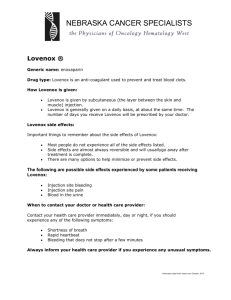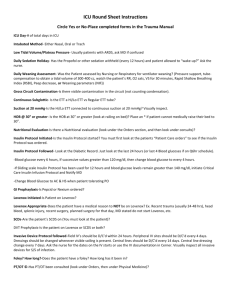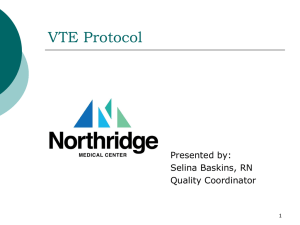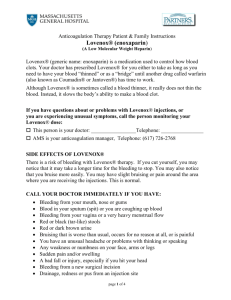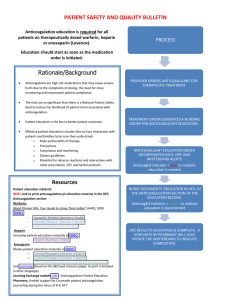Uploaded by
April Territo
LOVENOX Self-Injection Guide
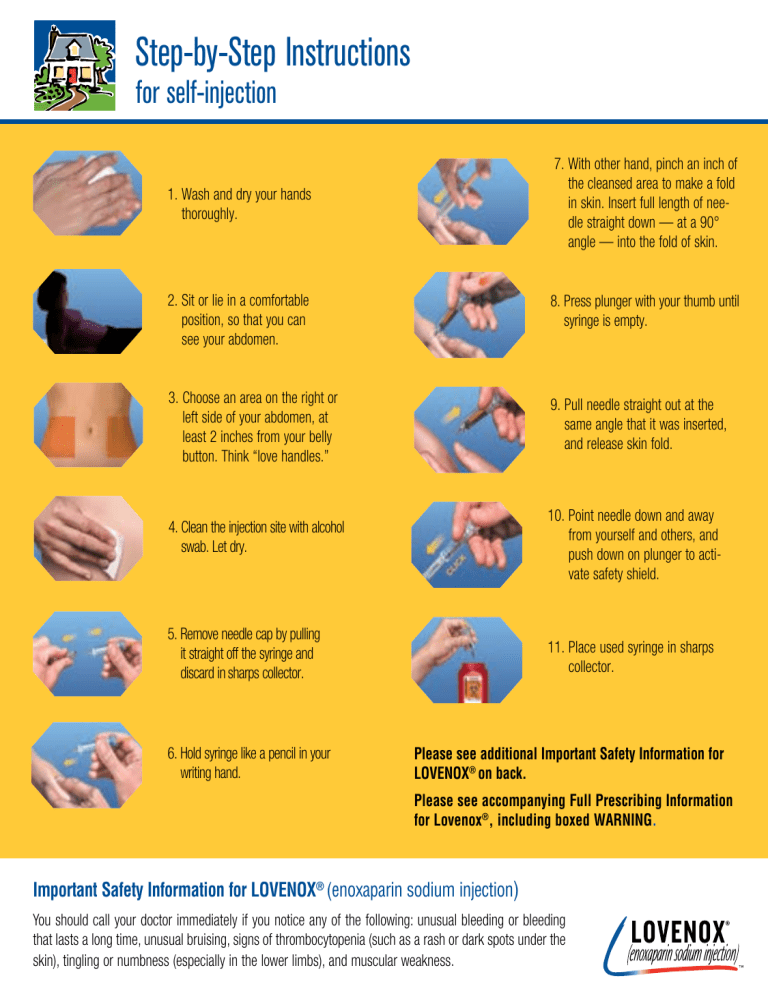
Step-by-Step Instructions for self-injection 7. With other hand, pinch an inch of the cleansed area to make a fold in skin. Insert full length of needle straight down — at a 90° angle — into the fold of skin. 1. Wash and dry your hands thoroughly. 2. Sit or lie in a comfortable position, so that you can see your abdomen. 8. P ress plunger with your thumb until syringe is empty. 3.Choose an area on the right or left side of your abdomen, at least 2 inches from your belly button. Think “love handles.” 9. Pull needle straight out at the same angle that it was inserted, and release skin fold. 4. Clean the injection site with alcohol swab. Let dry. 10. Point needle down and away from yourself and others, and push down on plunger to activate safety shield. 5. Remove needle cap by pulling it straight off the syringe and discard in sharps collector. 11. Place used syringe in sharps collector. 6. Hold syringe like a pencil in your writing hand. Please see additional Important Safety Information for LOVENOX® on back. Please see accompanying Full Prescribing Information for Lovenox®, including boxed WARNING. Important Safety Information for LOVENOX® (enoxaparin sodium injection) You should call your doctor immediately if you notice any of the following: unusual bleeding or bleeding that lasts a long time, unusual bruising, signs of thrombocytopenia (such as a rash or dark spots under the skin), tingling or numbness (especially in the lower limbs), and muscular weakness. Indication for LOVENOX® (enoxaparin sodium injection) LOVENOX® can help reduce the risk of developing deep vein thrombosis (DVT) blood clots, which may lead to pulmonary embolism (PE), in patients undergoing abdominal surgery, hip- or knee-replacement surgery, or in acutely ill medical patients with severely restricted mobility. Important Safety Information for LOVENOX® If you are receiving epidural or spinal anesthesia or undergoing spinal puncture, and taking LOVENOX® (enoxaparin sodium injection), you may be at increased risk of developing a blood clot in or around the spine, which can result in long-term paralysis. Your risk may be further increased if you: • Take nonsteroidal anti-inflammatory drugs (NSAIDs), platelet inhibitors, or other anticoagulants, such as aspirin or blood thinners • Have an indwelling epidural catheter • Have a history of spinal trauma, or repeated spinal anesthesia or punctures • Have a history of spinal deformities or spinal surgery It is important to contact your doctor immediately if you experience symptoms such as tingling, numbness (especially in the lower limbs), or muscular weakness. LOVENOX® should not be used in patients who are actively bleeding or who have a low count of blood cells called platelets, which aid in clotting. This is a condition called “thrombocytopenia.” LOVENOX® also should not be used in patients who are allergic or sensitive to LOVENOX® or enoxaparin, heparin, or pork products. LOVENOX® must be used with care in patients who have any of the following: problems with clotting, uncontrolled high blood pressure, a recent ulcer, impaired vision due to diabetes, kidney problems, and excessive bleeding. Pregnant women with mechanical prosthetic (artificial) heart valves may be at higher risk for blood clots. These patients who are treated with LOVENOX® must be carefully monitored by their doctor. Some patients on LOVENOX® can experience drops in their platelet counts, a condition called “thrombocytopenia.” Also, a serious but rare condition called “heparin-induced thrombocytopenia” can occur with LOVENOX®. If you have had this condition, you must promptly notify your healthcare professional. LOVENOX® alters the blood’s ability to clot. Excessive bleeding (hemorrhage), leading to death, has occurred with LOVENOX®. Bleeding can occur at any site with LOVENOX® use. The use of aspirin and other NSAIDs may enhance the risk of excessive bleeding. Be sure to tell all your doctors and dentist about all of the medications you are taking, including those you are taking without a prescription, such as aspirin or other NSAIDs. Also be sure to tell your doctor or dentist you are taking LOVENOX® before any surgery is scheduled and before any new drug is taken. All patients should be carefully monitored by their doctor while taking LOVENOX®. Your doctor is likely to obtain blood tests that measure your blood count and check for signs of hidden bleeding while you are on LOVENOX®. You should call your doctor immediately if you notice any of the following: unusual bleeding or bleeding that lasts a long time, unusual bruising, signs of thrombocytopenia (such as a rash or dark spots under the skin), tingling or numbness (especially in the lower limbs), and muscular weakness. The most common side effects from the use of LOVENOX® are mild pain, irritation, bruising, or redness of the skin at the site of injection. Other common side effects include bleeding, anemia, diarrhea, nausea, ecchymosis, fever, edema, peripheral edema, dyspnea, confusion, and injection site pain Do not stop taking LOVENOX® without first talking to the doctor who prescribed it for you. For specific questions about your health, you should always consult your doctor or a qualified healthcare professional who is responsible for your care. Please see accompanying full prescribing information for LOVENOX®, including boxed WARNING, for additional important information. © 2018 sanofi-aventis U.S. LLC. ALL RIGHTS RESERVED SAUS.ENO.18.01.0195
